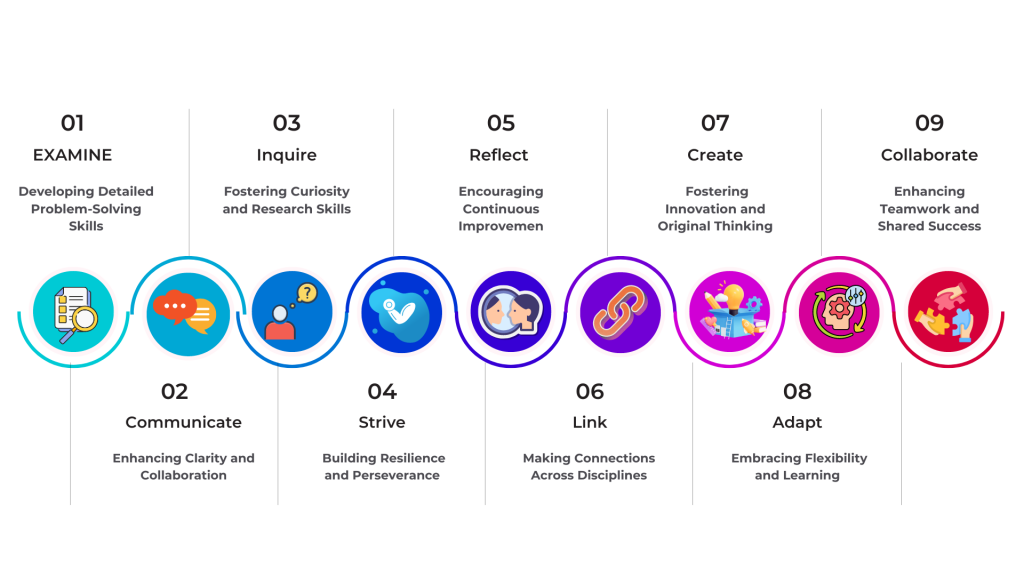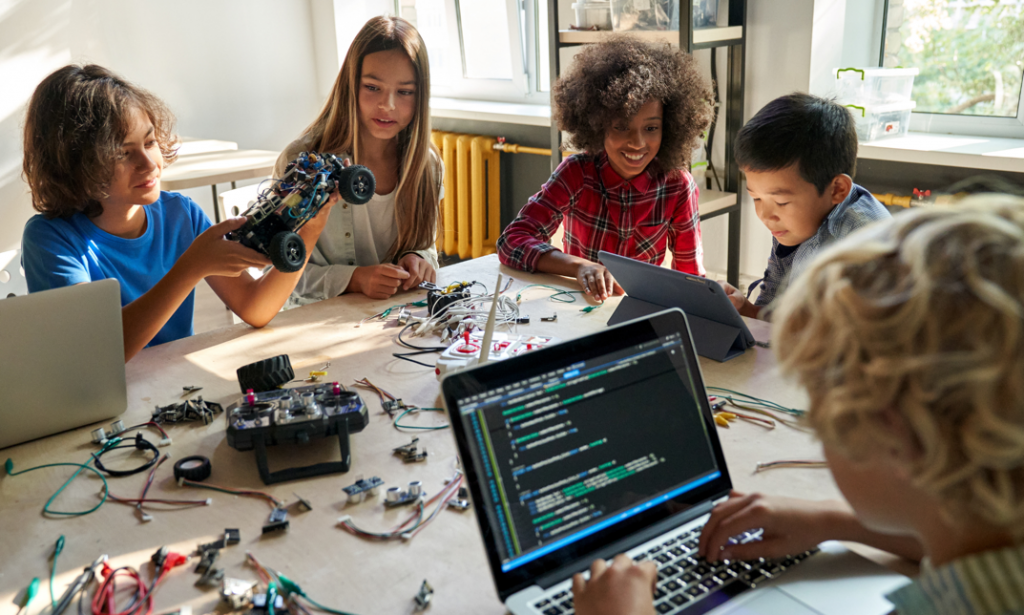In today’s rapidly evolving technological landscape, it’s crucial to equip our children with the skills they need to thrive. Critical thinking stands out as one of the most essential abilities. Learning to code is a powerful method to stimulate this vital skill, transforming students into adept problem-solvers and innovative thinkers. Coding isn’t just about writing programs; it’s about breaking down complex problems, thinking logically, and creating innovative solutions. It teaches children to approach challenges methodically, develop creativity, and build resilience through trial and error.
In this blog, Nurturing Critical Thinking through Coding, we’ll explore the myriad ways in which learning to cultivates essential skills that prepare children for the future. Join us as we delve into the transformative power of coding in education and its crucial role in shaping the next generation of critical thinkers.
Cultivating Young Minds: 9 Critical Thinking Traits Enhanced by Coding

1. Examine: Developing Detailed Problem-Solving Skills
- Coding encourages children to examine problems, meticulously breaking them down into manageable parts. Debugging requires careful attention to detail, enhancing their problem-solving skills.
- For instance, if a game character isn’t moving correctly, children must analyse the code controlling movement and input commands to identify the issue.
This process not only sharpens their ability to examine problems in detail but also improves their communication skills.
2. Communicate: Enhancing Clarity and Collaboration
-
- Clear communication is crucial in coding, where instructions must be precise for the program to function correctly.
- Children learn to express their ideas clearly and collaborate with peers, enhancing their communication skills both in writing and verbally.
- For example, writing a program to calculate the area of different shapes involves explaining each step through comments in the code, ensuring others can understand and use their work.
3. Inquire: Cultivating Curiosity and Research Skills
-
- Coding sparks curiosity and encourages children to ask questions. They learn to seek answers through experimentation and research, cultivating an inquisitive mindset essential for lifelong learning.
- For instance, a child curious about making a button change color when clicked might explore CSS and JavaScript techniques, experimenting until they find the right solution.
4. Strive: Building Resilience and Perseverance
Coding projects often present challenges that require persistence and resilience. By striving to overcome these challenges, children develop a growth mindset, understanding that effort and perseverance lead to success. For example, when a mobile app repeatedly crashes, children learn to persevere by testing different solutions, seeking help, and refining their code until the app works perfectly. This process teaches them that effort and perseverance are key to success.
This natural curiosity often leads to further exploration and learning.
5. Reflect: Encouraging Continuous Improvement
Reflection is a key part of the coding process. Children review their work, identify mistakes, and consider ways to improve. This reflective practice helps them develop critical thinking and self-assessment skills. After completing a robotics project, for example, children might review their code to find ways to make it more efficient or to add error-checking mechanisms. This ongoing process of reflection encourages continuous improvement.
6.Link: Making Connections Across Disciplines
Coding teaches children to make connections between different concepts and apply their knowledge to new situations. They learn to link coding principles with real-world applications, enhancing their ability to transfer skills across contexts. For instance, understanding how loops work in coding can help children recognize patterns in math and literature, demonstrating the interdisciplinary nature of coding skills.
7. Create: Cultivating Innovation and Original Thinking
Creativity is at the heart of coding. Children use their imagination to create games, apps, and websites, turning abstract ideas into tangible outcomes. This creative process encourages innovation and original thinking. Designing a new video game, for example, involves creating characters, levels, and storylines, bringing an imaginative vision to life. This process allows children to see the direct impact of their creativity.
8. Adapt: Embracing Flexibility and Learning
The coding environment is constantly changing, with new languages and tools emerging regularly. Children learn to adapt to these changes, developing flexibility and the ability to learn new skills quickly. For instance, switching to a new version of a programming language or adopting a different library for better functionality teaches children to stay current and adaptable. This adaptability is crucial for thriving in a fast-paced, ever-evolving world.
9. Collaborate: Enhancing Teamwork and Shared Success
Many coding projects are collaborative, requiring children to work in teams. They learn to share ideas, give and receive feedback, and work towards common goals, enhancing their teamwork and collaboration skills. Developing a school website, for example, might involve dividing tasks among team members, holding regular meetings, and integrating each person’s contributions. This collaborative experience mirrors real-world working environments.
The Best Age to Start Coding
The best age to start coding can vary depending on the child’s interest and developmental stage, but many experts suggest that children can begin learning basic coding concepts as early as 5 to 7 years old.

At this age, they can start with simple, visual programming languages like Scratch or Blockly, which use drag-and-drop blocks to teach fundamental programming logic and concepts.
Here are some age-appropriate coding activities:
- Ages 5-7: Simple visual programming tools like ScratchJr, which help children understand the basics of sequencing, loops, and problem-solving through fun, interactive stories and games.
- Ages 8-10: More advanced visual programming tools like Scratch, Blockly, or introductory robotics kits that offer more complex problem-solving challenges and introduce basic programming structures.
- Ages 11-13: Transition to text-based programming languages such as Python, JavaScript, or HTML/CSS. At this stage, children can start working on simple projects like building websites, creating basic games, or programming robots.
- Ages 14 and up: Focus on more advanced programming languages and concepts, including Java, C++, or Swift. Students can work on complex projects, contribute to open-source projects, or prepare for coding competitions.
Ultimately, the best time to start coding is when a child shows interest and enthusiasm for technology and problem-solving. Encouraging and supporting their learning at any age will help them develop valuable skills for the future.
Practical Ways Parents Can Support Their Child’s Coding Journey
Parents play a crucial role in supporting their child’s coding journey. Here are some practical ways parents can help:

1. Create a Supportive Environment
- Encourage exploration with different coding platforms.
- Provide resources like a computer, internet, and software.
- Designate a quiet space for coding.
- Foster a Growth Mindset
- Celebrate efforts and persistence.
- Teach that mistakes are part of learning.
- Get Involved
- Learn basic coding concepts together.
- Engage in discussions about their projects.
- Encourage Project-Based Learning
- Support personal projects.
- Help set up a portfolio to showcase their work.
- Provide Emotional Support
- Be patient and understanding.
- Offer encouragement and motivation.
- Promote Balanced Learning
- Ensure a balanced schedule with various activities.
- Monitor screen time to prevent burnout.
By following these steps, parents can greatly enhance their child’s coding experience. SkoolOfCode offers valuable resources and support to help your child thrive in coding.
SkoolOfCode Online Coding Classes
SkoolOfCode offers top-notch online coding classes for kids designed to cultivate critical thinking and 21st-century skills in children aged 6-16. Our expert teachers, with strong backgrounds in computer science, guide students through a holistic STEM-based curriculum. From introductory coding courses to advanced programming in Python and Java, SkoolOfCode ensures a comprehensive learning journey. Our classes are engaging and interactive, focusing on practical, hands-on learning. We prepare students for advanced placement in computer science, ensuring they are well-equipped for academic and professional success. At SkoolOfCode, we are committed to nurturing the next generation of thinkers, innovators, and leaders.
Conclusion
Coding is a powerful tool for developing critical thinking and essential 21st-century skills. Through coding, children learn to examine, communicate, inquire, strive, reflect, link, create, adapt, and collaborate—traits that will serve them well in all areas of life. With the support of quality online coding classes for kids like those offered by SkoolofCode, your child can embark on a rewarding journey of discovery and growth.
Explore our courses today and give your child the tools they need to thrive in a digital world. Visit SkoolofCode to learn more about our programs and enrol your child in a class that will set them up for success. For the best coding classes for kids and to start programming for beginners, SkoolofCode offers an unparalleled learning experience in computer programming for kids. Don’t wait—start your child’s coding journey with us now!
FAQ for Parents: Nurturing Critical Thinking through Coding
Q1: What is the importance of critical thinking in today’s world?
A1: Critical thinking is crucial because it enables individuals to analyse complex problems, make informed decisions, and innovate solutions. In our rapidly evolving technological landscape, these skills are essential for personal and professional success.
Q2: How does learning to code help develop critical thinking skills?
A2: Learning to code encourages critical thinking by teaching children to break down complex problems, think logically, and create innovative solutions. Coding involves examining problems in detail, testing hypotheses, and refining solutions through trial and error, which enhances problem-solving and analytical abilities.
Q3: What specific skills can coding help children develop?
A3: Coding helps children develop a wide range of skills, including:
- Detailed problem-solving
- Clear communication
- Curiosity and research skills
- Resilience and perseverance
- Continuous improvement through reflection
- Making interdisciplinary connections
- Creativity and innovation
- Flexibility and adaptability
- Teamwork and collaboration
Q4: Can you provide an example of how coding enhances problem-solving skills?
A4: When coding, children might encounter a bug that prevents a game character from moving correctly. They need to analyse the code, understand the logic, and identify the issue. This meticulous examination and debugging process sharpens their problem-solving skills and attention to detail.
Q5: How does coding improve communication skills?
A5: Coding requires precise instructions for a program to function correctly. Children learn to express their ideas clearly through written code and comments, and to communicate effectively with peers during collaborative projects. This practice enhances their clarity in both written and verbal communication.
Q6: How does coding helps creativity?
A6: Coding is inherently creative as it involves designing and building new programs, games, or apps. Children use their imagination to bring abstract ideas to life, which encourages innovation and original thinking. For instance, creating a video game involves developing characters, levels, and storylines.
Q7: How does coding teach resilience?
A7: Coding projects often present challenges that require persistence to overcome. Children learn that encountering errors and failures is a natural part of the coding process. By persevering through these challenges, they develop resilience and a growth mindset.
Q8: In what ways does coding encourage reflection and continuous improvement?
A8: After completing a coding project, children review their work, identify mistakes, and consider ways to improve their code. This reflective practice helps them develop critical thinking and self-assessment skills, encouraging continuous improvement.
Q9: How does coding help children make connections across different subjects?
A9: Coding involves principles that can be applied to various disciplines. For example, understanding loops in coding can help children recognize patterns in math and science. This interdisciplinary approach enhances their ability to transfer skills across different contexts.
Q10: Why is adaptability an important skill learned through coding?
A10: The coding environment is constantly evolving, with new languages and tools emerging regularly. Learning to adapt to these changes helps children develop flexibility and the ability to learn new skills quickly, which is crucial in today’s fast-paced world.
Q11: How does coding promote teamwork and collaboration?
A11: Many coding projects are collaborative, requiring children to work in teams. They learn to share ideas, give and receive feedback, and work towards common goals. This collaborative experience mirrors real-world working environments and enhances their teamwork skills.
Q12: Why should I consider online coding classes for my child?
A12: Online coding classes provide a flexible and accessible way for children to learn coding. They can learn at their own pace, access a wide range of resources, and connect with instructors and peers globally. This broadens their perspectives and enriches their learning experience.
Q13: What makes SkoolOfCode online coding classes unique?
A13: SkoolofCode offers high-quality online coding classes for kids, designed to cultivate critical thinking and 21st-century skills. Our expert teachers guide students through a comprehensive STEM-based curriculum, from introductory courses to advanced programming. Our interactive, hands-on approach ensures a rewarding learning journey.
Q14: How can coding prepare my child for future success?
A14: Coding teaches logical thinking, problem-solving, and creativity, skills that are highly valued in any career. It prepares children for the digital future by equipping them with tools to tackle complex challenges, innovate solutions, and adapt to new technologies.
Ms.Manpreet Virk, an educator at SkoolOfCode with a degree in M.Phil and Master in Computer Science. She is passionate about learning and teaching young minds.

